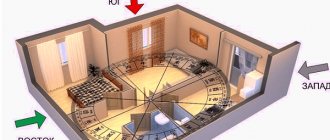North, south, west, east - the location of geographical directions can be determined by a mobile phone, a magnetic compass, and nature itself. It is impossible to exclude a situation when the necessary objects to help you find out the directions of the world are not nearby, and you will have to find the path yourself. There are guidelines that travelers need in every possible situation.
Orientation without a compass
Learning to navigate a backpacking trip is extremely important, especially in sparsely populated and unfamiliar areas. This will help you not get lost and survive. In addition, the accuracy of following the laid route and achieving the goal depends on the correct choice and skillful use of various methods and techniques to navigate the area.
Sunny skies make it easy to navigate the terrain
There are different ways to determine one side or another:
- Classical methods include a compass and a map.
- Among modern methods, topographic maps are popular. They help define a large area. Ground navigation devices help determine the terrain and follow the laid route.
A magnetic compass is considered one of the simplest navigation devices, but quite often you have to operate without a map and compass. In this case, the stars, the sun and various natural phenomena will help you.
LUsing a classic compass: The ABCs of orientation - how to use a tourist compass
LOriginal method in the absence of a map: Orientation by sound - advantages and disadvantages of the method
Gyro-compass
At the very end of the 19th century, in response to the development of battleships with large transverse guns that acted on magnetic compasses, and perhaps to avoid the need to wait for good weather at night. In order to accurately check its alignment with true north, a gyrocompass was developed . Because it finds true poles rather than magnetic ones, it is immune to interference from magnetic fields.
Its main drawback is that it relies on technology that many people may find too expensive to be worthwhile outside the context of a large commercial or military operation.
How to determine cardinal directions by the sun
If you go hiking without any navigation, the first thing that will help you not get lost is the sun. At dawn it is located on the eastern side, and at sunset it moves to the west. Face it at sunrise: you will have north on your left, south on your right, and west on your back.
Sun orientation
This determination method is one of the simplest and most frequently used, although it does not provide 100% accuracy. It is almost impossible to determine your location using the sun when it is cloudy outside. In addition, there are a number of other nuances:
- our country is located in the northern hemisphere, here the sun rises from the eastern side and sets from the western side exclusively on March 21 and September 23;
- in spring and summer its position is slightly shifted to the north, with the approach of the winter period - to the south, on June 21 - to the northeast and northwest, on December 21 - to the southeast and southwest.
Watch
We place the device on a horizontal place so that the arrow points to the celestial body. Next, we divide the angle formed between the number twelve and the arrow into two equal parts. The line in the middle will point south.
Orientation by clock
If you want to determine the accuracy of your location before lunch, you need to divide the sector with the hour hand that passed before 13:00. After noon we divide the arrow that passed after 13:00.
Shadow
Take a long stick about 0.5 m long and drive it into the ground. Next, you need to watch how the length of the shadow changes until it becomes very short. This is a sign that the sun is at its zenith and the shadow points north.
Stick and stone
The method is similar to the previous one - first we stick a stick into the ground, and place a pebble or any other heavy object on the tip of the reflective shadow. After 15 minutes, we make another mark and connect both stones with a stick. The first pebble will point to the east, and the second to the west. Next we place another stick perpendicularly. In the place where the shadow casts there will be south, on the contrary - north.
LYou can also tell the time by the luminaries. How? Read here: How to find out the exact time without a watch while hiking
Origin of ancient names
During the invasion of the Huns, names from Germanic languages for cardinal directions entered the Romance languages, where they replaced Latin names. Some northerners used Germanic names for intermediate destinations.
In many regions of the world, prevailing winds change direction seasonally, and so many cultures associate specific winds with cardinal and intercardinal directions. For example, classical Greek culture characterized these winds as Anemoi.
In post-medieval Europe, cardinal and intercardinal movements were given names. These often corresponded to the directional winds of the Mediterranean (for example, the southeast was associated with the Sirocco, a wind from the Sahara).
Finding North and South by the moon
Moon in the sky
To accurately find the direction you need, you should know all the phases of the moon:
- In the first quarter it grows, so its tips will be directed to the left. At 7 pm the moon will be in the south, and at 1 am it will move to the west.
- There is a full moon in the second quarter. By 7 o'clock in the evening the heavenly body will be visible in the east, and after midnight - in the south.
- In the third phase, when the moon is waning, the horns of the month are turned to the right. At one o'clock in the morning it will be in the east, and by seven o'clock in the morning it will be in the south.
Another important point is how to determine the direction of the world on a moonless night, when clouds have eclipsed the moon. Take a closer look at the tree trunks - on the side where the moss grows, there will be north. You can determine the south by the anthill. As a rule, it is located on the south side of the tree.
Satellite navigation
At the end of the 20th century, the advent of satellite global positioning systems provided another means of accurately determining true north. Government agencies in charge of satellites constantly monitor and adjust them to maintain their precise alignment with the Earth.
Unlike a gyrocompass, which is most accurate when stationary, a GPS receiver, if it has only one antenna, must move, usually at speeds greater than 0.2 km/h, to correctly display compass directions. On ships and aircraft, receivers are often equipped with two or more antennas separately attached to the vehicle.
North and South according to the starry sky
Don't worry if you get lost in the dark; several effective methods will help you find your way around without a compass.
polar Star
Since childhood, we have known about the existence of the North Star, which stands out among the many small lights in the sky. It is located in the constellation Ursa Minor.
Orientation by the stars
The North Star is located at the very top and has a bright light. It points north, but only if you are looking directly at it. Accordingly, the western side will be on your right, the eastern side on your left, and the southern side behind you.
Constellation Cassiopeia
Outwardly, it resembles the letter “M” when high in the sky, and the letter “W” when low above the horizon.
Cassiopeia
This constellation revolves around the North Star. The outermost and lowest star from the letter “M” is located at the same distance as the Big Dipper’s bucket.
South Cross
This method of determining terrain is only effective if you are in the southern hemisphere. Finding the Southern Cross constellation is not difficult. It appears in the shape of a cross and consists of four stars.
Correct definition of the Southern Cross
You will need the long part of the figure, its axis or the so-called pointer. We take the lower part of the axis as a basis, draw five segments from it equal in length to the axis. The end point will be in a southerly direction.
Use of cardinal points for making maps
Thus, with the cardinal points precisely defined, by convention cartographers draw standard maps with north (N) at the top and east (E) at the right . In turn, maps provide a systematic means of recording places, and cardinal directions provide the basis for a structure for locating those places.
In the real world there are six cardinal directions not related to geography, which are north, south, east, west, up and down. In this context, up and down refer to height, or perhaps depth (if water is involved). A topographic map is a special case of cartography in which elevation is indicated on the map, usually through contour lines.
Navigating natural phenomena without a compass
There are several more simple ways to determine the cardinal directions without a compass.
- Lichens and mosses. They generally prefer to grow on the north side of the wood of living and dead trees.
- For lost tourists in the mountains, one simple rule applies: in the south, on the northern side of the mountains, coniferous trees predominantly grow, and on the southern side, deciduous trees.
- In the sultry heat, you can determine the location by looking at the resin on the bark of coniferous trees. Such discharge appears on the south side of the wood.
- Mushrooms. As a rule, they grow on the north side of trees.
- Sunflower heads are always turned to the east.
- Soil moisture. You need to look at the soil near the stones. In the summer, it will be more humidified on the north side.
- Rings on a stump. As a rule, the center of the rings on the trunk cut is shifted to the north.
- Snow melts faster on southern slopes, forming notches directed to the south.
- The altars of Orthodox churches, Lutheran kirks and chapels always face east, and the main entrances are located on the west side.
L You can also find out the weather by natural phenomena: Ways to find out the weather by signs for tomorrow
Near East
The word “east” is used as a contrast to the countries of Western Europe. From a geographical point of view, countries belonging to the Middle East are not located in the East in relation to Europe.
The historical name of the Middle East is given to a large region of Asia and North Africa. It includes 17 countries inhabited by Armenians, Arabs, Turks, Kurds, Assyrians, Persians, Jews and other nationalities. For the most part, these are representatives of Islam, but there are also many Christians, Jews, Druze and Yazidis.
These areas are of strategic importance, as large hydrocarbon deposits are located here. The Middle East is a zone of constant military conflicts. This is a politically unstable area, since it is here that the Israeli-Palestinian conflict, the wars in Iraq and Syria are taking place, and the problematic Afghanistan is located. It is from the Middle East that Islamic extremism spreads.
Far East of Russia
This region occupies 34% of the country's territory. It includes the Primorsky, Kamchatka and Khabarovsk territories, the Chukotka Autonomous Okrug, the Republic of Sakha-Yakutia, the Jewish Autonomous Region, the Amur, Magadan and Sakhalin regions.
The region of the Far East is predominantly mountainous and seismic. The Pacific coast is prone to cyclones and tsunamis. There are active volcanoes on the Kamchatka Peninsula, the most active of which is Klyuchevaya Sopka. This area is rich in mineral resources: gold, nickel, tin, mercury, manganese, tungsten, polymetallic ores, brown and hard coal, oil and gas. Mineral resources have been explored, but practically untouched.
The area is sparsely populated, with 7 million people living in a vast area larger than Western Europe. This is mainly due to inaccessibility. Development of the northern regions is currently not possible. Most of the Russian Far East belongs to the Far North regions.











